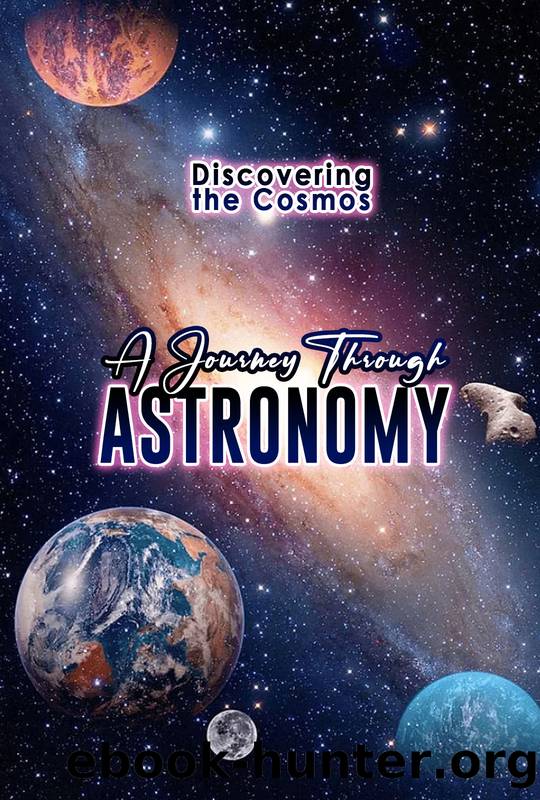Discovering or Cosmos: A Day on Astronomy by R. Raphael

Author:R., Raphael
Language: eng
Format: epub
Published: 2024-02-20T00:00:00+00:00
Chapter 10: Observational Astronomy: Tools and Techniques
In this chapter, we will explore the various tools and techniques used by astronomers to observe and study the universe. From ground-based telescopes to space observatories, we will learn how these technologies allow us to unlock the mysteries of the cosmos.
Earth Telescopes
Ground-based telescopes are optical instruments that allow us to observe the sky from the Earth's surface. They can be used to study celestial objects at different wavelengths, including visible, infrared and ultraviolet light.
Space Telescopes
Space telescopes are placed in orbit around the Earth or on dedicated space missions to avoid atmospheric distortion and interference from Earth's light. They offer a clearer and more accurate view of the universe in different spectral ranges.
Astronomical Observatories
Astronomical observatories are facilities dedicated to astronomical observation and research. They can include a variety of specialized telescopes and instruments to study different aspects of the cosmos, from planets in the solar system to distant galaxies.
Observation Techniques
In addition to telescopes, astronomers use a variety of techniques to study the universe, including photometry, spectroscopy, interferometry, and direct imaging. Each technique provides valuable information about the composition, temperature, speed and other properties of celestial objects.
Multimedia Observation
Multimedia observation combines data collected at different wavelengths and techniques to obtain a more complete and detailed view of the universe. This includes observations in visible light, infrared, ultraviolet, radio and X-rays.
Challenges of Astronomical Observation
Astronomical observation faces several challenges, including light pollution, radio interference and atmospheric turbulence. Astronomers develop advanced techniques and use remote, high-altitude locations to minimize these effects.
Contributions of Observational Astronomy
Observational astronomy plays a fundamental role in our understanding of the universe. It allows us to study celestial objects at different stages of evolution, investigate astronomical phenomena and test fundamental theories of physics.
Observational astronomy is a powerful tool that allows us to explore the mysteries of the cosmos and expand our knowledge of the universe. In the next chapters, we will continue our journey through space, exploring more deeply astronomical phenomena and the wonders of the cosmos.
Download
This site does not store any files on its server. We only index and link to content provided by other sites. Please contact the content providers to delete copyright contents if any and email us, we'll remove relevant links or contents immediately.
Whiskies Galore by Ian Buxton(41879)
Introduction to Aircraft Design (Cambridge Aerospace Series) by John P. Fielding(33064)
Rewire Your Anxious Brain by Catherine M. Pittman(18553)
Craft Beer for the Homebrewer by Michael Agnew(18140)
Cat's cradle by Kurt Vonnegut(15184)
Sapiens: A Brief History of Humankind by Yuval Noah Harari(14252)
Leonardo da Vinci by Walter Isaacson(13182)
The Tidewater Tales by John Barth(12608)
Thinking, Fast and Slow by Kahneman Daniel(12073)
Underground: A Human History of the Worlds Beneath Our Feet by Will Hunt(12024)
The Radium Girls by Kate Moore(11921)
The Art of Thinking Clearly by Rolf Dobelli(10221)
A Journey Through Charms and Defence Against the Dark Arts (Harry Potter: A Journey Throughâ¦) by Pottermore Publishing(9232)
Mindhunter: Inside the FBI's Elite Serial Crime Unit by John E. Douglas & Mark Olshaker(9201)
Tools of Titans by Timothy Ferriss(8218)
Wonder by R. J. Palacio(8010)
Turbulence by E. J. Noyes(7936)
Change Your Questions, Change Your Life by Marilee Adams(7635)
Nudge - Improving Decisions about Health, Wealth, and Happiness by Thaler Sunstein(7615)
